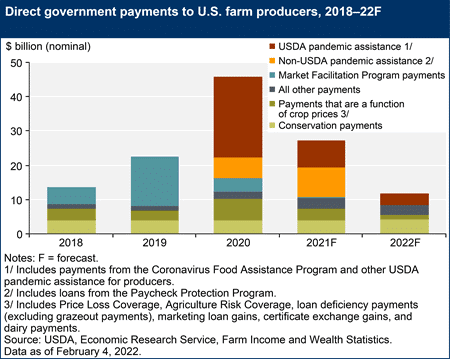Farm Income Outlook for 2022
Net farm income in 2022 is showing a slightly softer forecast than 2021—but still 26 percent higher than the 10-year average.
According to the latest USDA farm sector income forecast report, production expenses and a drop in direct government payments are officially making their dent in net farm income in 2022. Even so, strong market prices and export demand are keeping the news surrounding the 2022 farm income outlook mostly positive.
February Report Highlights: Farm Income in 2022
After the highest farm income since 2013 in 2021, the net farm income forecast for 2022 dropped to $113.7 billion—a 4.5 percent decline from 2021 but still above both the 2020 levels and the 20-year average. At $136.1 billion, net cash farm income—which excludes economic depreciation and inventory adjustments—is forecasted to increase 1.4 percent from 2021 and will also be above 2020 and 20-year average levels.

When adjusted for inflation, the forecast tells a slightly different story, showing a 7.9 percent decline in net farm income from 2021 to 2022 and a 2.1 percent decline in net cash farm income from 2021.
Cash Receipts
Overall cash receipts for major ag commodities are forecasted to increase 6.8 percent in 2022. Percentage increases in cash receipts by ag commodity in 2022 from highest to lowest are:
- Cotton receipts are forecasted to increase 33.8 percent;
- Milk receipts are forecasted to increase 22.1 percent;
- Broiler receipts are forecasted to increase 12.3 percent;
- Wheat receipts are forecasted to increase 10.6 percent;
- Soybean receipts are forecasted to increase 8.9 percent;
- Cattle and calf receipts are forecasted to increase 8.5 percent;
- Potato receipts are forecasted to increase 6.1 percent;
- Corn receipts are forecasted to increase 4.8 percent;
- Fruit and nut receipts are forecasted to increase 4.8 percent;
- Turkey and chicken egg receipts are forecasted to increase 3 percent;
- Vegetable and melon receipts are forecasted to increase 2.5 percent; and
- Hog receipts are the only sector forecasted to decline at 10.3 percent.
Note: These increases are in nominal terms. When adjusted for inflation, cash receipts for turkey, chicken eggs, vegetables, and melons show a decline from 2021.
Production Expenses
Total production expenses for U.S. agriculture are expected to increase by 5.1 percent to $411.6 billion in 2022. Nearly all categories of expenses increased across the board, with the highest increases including fertilizer, feed, and labor.
- Fertilizer prices are forecasted to increase an estimated 12 percent.
- Feed costs are forecasted to increase 6.1 percent.
- Labor costs are forecasted to increase 5.9 percent.
The increasing cost of inputs is a driving factor behind the projected decline in net farm income, as is the substantial drop in direct government payments.
Direct Government Payments
Direct government payments accounted for nearly half of farm income in 2020. In 2021, that percentage fell to nearly a quarter of the net farm income. In 2022, direct government payments will account for an estimated 10 percent of net farm income.

The decline in direct government payments is mostly attributed to a drop in ad hoc payments for COVID-related relief. Conservation payments are forecasted to increase 7.3 percent from 2021. It’s important to note that this projection could change depending on the outcome of the conservation funding proposed in the Build Back Better Plan and future legislation.
Hope for the Best, Prepare for the Unexpected
Overall, despite higher production expenses and a substantial drop in direct government payments, the outlook for farm income in 2022 is looking strong. That being said, a lot can happen between now and the next farm income forecast report—scheduled to be released in August 2022.
Rather than taking a wait-and-see approach, many farmers and ranchers are proactively locking in prices and securing flexible working capital to ensure all their bases are covered. AgAmerica is helping our clients do just that with our customizable loan products—such as our 10-year line of credit—free of annual renewals and nonuse fees.
Visit our free financial health check tool to gain more insight into the current financial state of your operation and the opportunities you have available to strengthen it.






